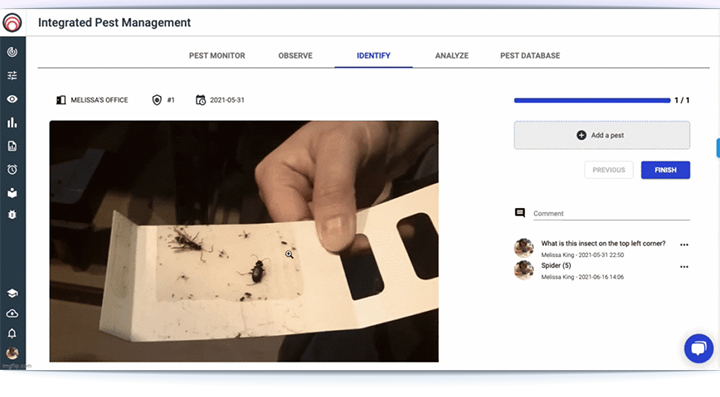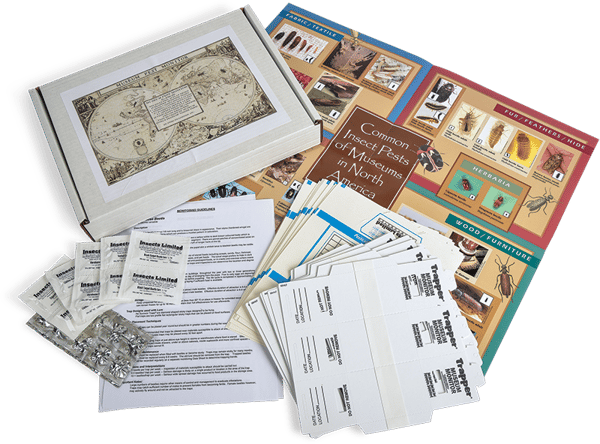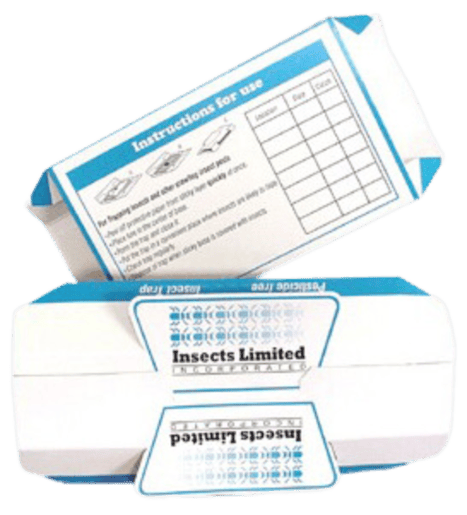Integrated Pest Management
What is it and why should we do it?
Why should I monitor pests?
Pests are agents of deterioration, one of the ten commonly recognized threats to heritage objects, and pests are everywhere!
What is a pest?
A “pest” is a living organism that harms cultural heritage collections or property, and/or hinders the ability of an institution's staff to achieve its mission. Insects, rodents, birds and other creatures can all be pests if they turn up in the wrong environment (like your museum, library or historic home!). Because insects are so ubiquitous and capable of causing such severe damage, insect monitoring systems are especially important for cultural heritage collections.
How do pests damage collections, and what kinds of collections are most at risk from pests?
Pests can eat, bite, scratch, tunnel through, stain and foul collections. Some species of insects feed on material that makes up our cultural heritage. In a worst-case scenario, hungry insects can destroy an object. Pest pupating, nesting or otherwise transforming items into a cozy home can also soil and damage collections.
Organic materials made from plants and animals are most at risk. Taxidermy, certain textiles, dried plants and seeds, books, parchment and vellum, furniture, insect specimens and all sorts of composite objects that incorporate plant fibers and elements of animal origin are vulnerable to pests. Different insect species and groups of species have different tastes. Protein feeders, like clothes moths and certain dermestid beetles, will consume fur, feathers, hide, wool, hair and other animal products. Other species, such as silverfish and firebrats, prefer cellulose-based food sources like paper, board and some textiles. Wood boring pests like powderpost and furniture beetles can wreak havoc on wooden furniture when their larvae hatch and chomp their way out.
Contemplating all of the potential pest risks to your collection can feel overwhelming, but it’s a relatively small group of pests that pose an active threat. Helpful lists like Insects Limited’s Dirty Dozen and those on their Insect Pests of Museums in North America Identification poster and posters by English Heritage illustrate the most common heritage pests.
So how do I protect my collection from pests?
Implement an IPM program! IPM stands for Integrated Pest Management, a multi-pronged prevention-oriented approach to pest management that seeks to safeguard collections while minimizing the use of toxic chemical pesticides. Historically, heritage custodians applied all sorts of toxic compounds to collections to stop insects from eating them. Over the past several decades, cultural heritage professionals have realized that these practices had unintended consequences -permanently contaminating objects and creating serious human health and environmental concerns. IPM is an alternative way to manage pests. It relies on practices like good housekeeping, excluding pests from the building, regular inspection and monitoring to prevent pest damage.
What does pest monitoring have to do with IPM and protecting my collection?
Monitoring pests is a cornerstone of an IPM program. Monitoring your spaces for pest activity helps you catch insect infestations early, allowing you to take action before significant damage occurs. Placing small monitors (or traps) throughout your spaces provides a sampling of the pests in the immediate environment. By periodically inspecting the monitors, you will learn about the presence of new pests, changes in insect populations, and where in your spaces pests are active. This knowledge informs other pest management activities.
How do you monitor pests?
Deploy monitors (or traps), focusing in areas where vulnerable collections are stored, near doors and corners, and around room perimeters. Come up with a naming and labeling system to keep track of your monitors and findings. Periodically inspect the monitors, typically once a month or once a quarter. Identify and record the contents. Analyze your pest data and take action accordingly. (Action might look like implementing more regular crack and crevice vacuuming, installing door sweeps or strips to seal the building better, or introducing species specific pheromone monitors to investigate a suspected infestation.)

What does pest monitoring have to do with environmental monitoring?
Pests and other environmental agents of deterioration, like incorrect temperature, incorrect relative humidity and light, act synergistically. Many pests, including collection pests like silverfish, prefer warm, dark, damp environments. One way to control pest activity is to modify the environment, making it less hospitable.
Keeping track of both collection and non-collection pests (organisms don’t pose a direct threat) also helps with understanding your building’s environmental conditions. The presence of indicator species, like psocids and fungus-eating plaster beetles, suggests that the environment may be more humid than is ideal for collections storage. Large numbers of various “nuisance” or invader pests coming inside the building signal that the building is not well sealed, which means that it’s vulnerable to collection pests and may be more sensitive to changes in exterior conditions.
Pest Monitoring Products

Pest Monitoring Kit >

HIRESIS Drugstore Beetle Kit >
Use this HIRESIS Drugstore Beetle Kit to safeguard your books and preserved plant material in natural history collections.

Insect Sticky Traps (10-Pack) >
Trap the insects most likely to be found in museums with these Insect Sticky Traps
Where can I learn more about IPM and pest monitoring?
- Museumpests.net - An in-depth resource for all things IPM, maintained by a dedicated group of collections care professionals and entomologists with cultural heritage experience.
- What’s Eating Your Collection? - A great UK-based website designed to help you understand what integrated pest management is, how to carry it out, and how it can help you in your museum.
- Gaylord Archival's Don't Be Bugged by Pests webinar with Allison Lewis
- Conserv’s IPM webinar course - Watch three one-hour webinars on IPM hosted by the preventive conservation platform Conserv.
- FUNdamentals of Museum IPM - A clear, practical handbook by Christa Deacy-Quinn.
Many thanks to conservator Allison Lewis for her assistance with this guide to IPM!

.png?width=450&height=348&name=g55001(1).png)
